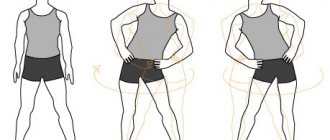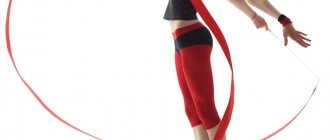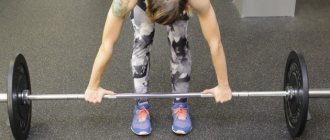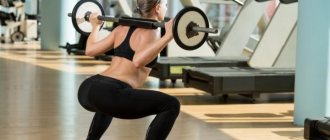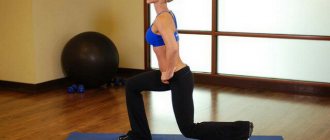Why do a warm-up?
By warming up before training, we get a wide range of benefits:
- Warming up the muscles. This improves our overall efficiency. It becomes easier to lift weights because warm muscles are more elastic than cold ones. The risk of injury is also reduced.
- Vasodilation occurs. This reduces the load on the heart. Blood flow also increases and our muscles receive more oxygen.
- Prepares the nervous system for hard work. Any physical activity is stressful for your body. Especially hard work in the gym with heavy weights. Therefore, in order to tune your nervous system in the right way, you should warm up.
- Warming up joints and ligaments. With a sedentary lifestyle, our joints lose their elasticity. And before you start training, it won’t hurt to stretch them. Otherwise, all sorts of problems with the articular-ligamentous apparatus may arise.
- Speeds up metabolism. Warm-up increases hormone levels. Such as: somatropin, dopamine and testosterone. Consequently, your efficiency during training will increase.
That is, in just 5-10 minutes, we will protect muscles and joints from serious injuries. We will also strengthen the cardiovascular system. Warming up helps us prepare the body by letting it understand that now you want to give your best in training. And he is required to be fully involved in the process. An analogy can be made with the operation of a car in winter. Before driving, the engine is warmed up. Due to this, all lubricating fluids become less viscous, and rubber seals are pressed through. That is, we spent a few minutes in order to reduce the wear of parts of our car. Consequently, its service life will be much longer. Warm-up does the same thing.
Warm-up procedures
Typically, the warm-up lasts 10 – 30 minutes, which means that all the desired content must be correctly placed in this period of time. Each warm-up is short, but over a 12-week training cycle, the accumulation of 10 to 30 minute warm-ups in each session results in a noticeable increase in training time.
For example:
A 15-minute warm-up done four times a week for 12 weeks equals 12 hours.
Over a 12-week training cycle, a training specialist could spend an additional 12 hours training. This clearly shows the importance and potential of a well-planned and effective warm-up.
To further develop modern exercise preparation practice, two warm-up models have been developed by Dr Ian Jeffries (4) and Mark Verstegen (11). Dr. Jeffries proposed the “RAMP” protocol, which makes it easy to classify and design a sequence of actions in a warm-up:
- Preparation (Raise)
- Activate and Mobilise
- Potentiate or Performance in an article with a modified version of the RAMP protocol.
The purpose of the warm-up for the training professional is to fully prepare the athlete psychologically and physically to complete the potentiation phase of the PAMP protocol and begin competition or activity. Each of the three phases plays an important role in the athlete’s preparation.
Phase 1: Preparation
The goal of the “preparation” phase is to increase:
- body temperature
- Heart rate
- breathing rate
- blood flow
- elasticity of joints.
Although the common practice of "stadium jogging" fits these criteria, this approach is considered a waste of valuable training time. The main goal of this phase must correspond to the described list, but can and should be performed using exercises or simplified sports activities that prevail during the lesson. For example, if an athlete is preparing for technical training in rugby, then this warm-up phase can include low-intensity movements in different directions or dynamic stretches, which will be a lot in the session. Examples of exercises for the “preparation” phase:
- technical elements of sprint running (special exercises)
- exercises with planned changes in direction of movement
- squats, lunges or walking on all fours.
Phase 2: Activation and mobilization
This phase has two goals:
- activation of key muscle groups
- increasing major joint mobility and range of motion in sports exercises or activities.
Typical movements that activate and increase mobility in this phase:
- exercises with small diameter ring expanders
- balance exercises
- "Superman" and "caterpillar"
- squats and lunges
- sumo move
- exercises for flexibility of the spine (flexion, extension, lateral bending and rotation).
These exercises can be done by most athletes training at the same time. But after the general exercises for the group are completed, more attention needs to be paid to individual training requirements. For example, these could be exercises planned in the athlete's prehabilitation program: specific exercises to increase flexibility, half-bridges, work with small diameter ring expanders, exercises for the rotator cuff, balance exercises, etc. Including these exercises in the warm-up increases the value of the used time by reducing the risk of injury and improving performance.
When planning the activation and mobilization phase, the strength and conditioning coach must consider the fundamental movements and demands of the individual sport or activity. What movements are fundamental for a rugby match or a weightlifting session in the gym? This will allow the coach to very accurately select warm-up exercises, which means there is a high chance of effectively preparing the athlete for training or competition and preventing injuries.
Trainers are encouraged to design a variety of exercises to activate key muscles and increase mobility of key joints to prevent monotony and focus on improving performance. Additionally, some exercises may cause pain or discomfort for some athletes, so reserve exercises for the same joints and muscle groups are necessary.
Phase 3: Potentiation or Realization (modified version)
The purpose of this phase is to optimize the athlete's condition for practice or competition.
In this phase, the warm-up focuses on exercises that will directly improve the results of subsequent activities. In this phase, the principle of post-activation potentiation is applied. The phase is inseparable from the main part, because it includes sport-specific activity with increasing intensity. During the phase, two main tasks are solved:
- raise the intensity to a level comparable to competition
- Increase the effectiveness of subsequent actions using the effect of post-activation potentiation.
Therefore, the potentiation/implementation phase includes intense exercises that are very specific to the sport. For example, in the potentiation phase of sprint running training, sprint-specific exercises can be planned - accelerations of 5 - 10 m, sprinting with a run of 30 - 40 m, plyometrics, etc. The training of football players can include plyometrics, training of reaction speed in difficult conditions and sprints with different distances and intensities.
An example of potentiation exercises in rugby for a lesson on playing technique:
- plyometric exercises (jumping and skipping on one and two legs)
- acceleration in short-medium distance running, sprints and 0 – 20 m
- processing blocking
- exercises for reaction speed (playing in difficult conditions).
After completing the three phases and gradually increasing the intensity of the exercises during the warm-up, athletes are sufficiently prepared for the upcoming activity or competition. The manual for this model does not provide approximate phase durations. These should be set by the strength and conditioning coach himself based on the time available, the physical needs of the athlete and the content of the body of the session, etc. Additional information on adjusting warm-up times is provided in the following sections of this article.
Stretches
Please note that static stretching was not mentioned or included in the pre-exercise routine. They are perhaps the biggest debate over warm-ups in decades. Despite the mandatory use of stretching in warm-up as a method of reducing the risk of injury and improving performance, there is little evidence that the use of passive stretching before or after exercise reduces injury (12 – 16). In addition, there is a growing body of research showing performance impairment from pre-exercise static stretching through reductions in force output (17, 18), power (19), running speed (20), reaction time (21), and strength endurance (22).
At the same time, dynamic stretching has been shown to have a consistently positive effect on subsequent performance (20, 23). Because dynamic stretches require muscle activation throughout the entire range of motion, they are considered to promote neural activation in the warm-up. As a result, dynamic stretching is the most appropriate form of increased mobility in the warm-up for most activities and sports that are naturally dynamic in nature.
Planning an Effective Warm-Up
To plan an effective warm-up, the strength and conditioning coach needs to understand the psychological, physiological and biomechanical demands of the training activity or sport before preparing the athlete for those demands. In most cases, these requirements are clarified when analyzing the goals.
For example, if a strength and conditioning coach is planning a warm-up to assess rep max, then he will need to consider the mental, psychological and biomechanical demands of the upcoming session. For mental preparation, a coach may recommend that the athlete arrive well rested and bring self-motivating music to listen to during the test, as this has been repeatedly shown to improve performance (24). For physiological preparation, the trainer can propose a warm-up procedure with physiological requirements similar to the RM assessment, including exercises with high effort and long rest. In terms of biomechanical training, stretches, dynamic movements, and exercises similar to those that will be assessed on the test (such as squats) are performed.
If a strength and conditioning coach is planning a warm-up to prepare for a “short and sharp” football technical session, then the warm-up is designed specifically for that session and is very different from the previous example of estimating RM. Of course, mental preparation is fundamentally different, since players' mental preparedness can be stimulated by competition with other players.
Physiologically, if technique training requires high volumes of work with short rest periods, hence greater stress on the cardiovascular system, then the warm-up should be similar to or even the same intensity as the class. From a biomechanical point of view, the selected movements should be biomechanically similar to the movements in technique training. You can include lunges, changes of direction, jumping and rotational movements.
Remember that the warm-up must be structured effectively and strategically using the PAMP protocol, and the content/exercises must replicate the activities in the session that the athletes are preparing for.
Effective approach
As mentioned earlier, over an extended period of time, each warm-up accumulates a significant number of training hours, so it is very useful to look for ways to optimize the performance gains from the warm-up. One of the ways to organize a warm-up to optimize it is to adapt the PAMP protocol and regulate the “Potentiation” component with an emphasis on “Implementation”. Therefore, the strength and conditioning coach needs to focus more on improving athletic performance in the warm-up, rather than simply preparing the athlete for the session. This method is simply an attempt to achieve maximum efficiency.
First, the strength and conditioning coach determines the current workout goal and then tailors the last portion of the warm-up to achieve that goal. For example, if a trainer's goal is to teach the fundamentals of plyometric exercises, he may structure the Implementation phase by modifying the PAMP protocol to achieve this goal.
If the coach's goal is to develop speed or agility, then the last part of the warm-up should simply include speed and agility exercises designed to improve one or both of these qualities. In particular, if a coach wants to develop a specific component of agility (speed of change of direction or reaction), then the “Implementation” phase of the warm-up should be specifically designed to improve this quality. As a result, a 20-minute warm-up before technical rugby training aimed at improving agility, with an emphasis on reaction speed, might look like this:
Preparation (5 minutes)
- low-intensity passes in a 20 x 20 m square
- or exercises to improve acceleration (running with high hips against a wall).
Activation and mobilization (5 minutes)
sport-specific movements to activate and increase mobility: hip abductions with an expander, “superman”, lunges, squats, sumo moves, spinal flexibility exercises.
Implementation (10 minutes)
- ratio 30/70* (change of direction for speed/reaction speed)
- changing direction to speed – organized/pre-planned movements (cone exercises).
- speed of reaction – games with evasions (for example, English Bulldog and variations).
*- the duration of exercises for each quality depends on the athlete’s skill in performing them. For example, an athlete with problems with change of direction needs to spend more time in training on this component (80/20 ratio - change of direction to speed/reaction speed).
Despite the 10-minute duration of the “Implementation” component in the warm-up, constructing a warm-up in this way optimizes the overall training time of the athlete in a long training cycle - 10 minutes X 4 times a week, for 12 weeks - this is an additional 8 hours of effective training.
The Implementation component (agility, plyometrics, or speed) can and probably should be modified systematically. For example, weeks 1 – 4 of the training cycle focus on increasing speed, weeks 5 – 9 focus on agility. The trainer can change the implementation component on a daily basis. Day 1 (Monday) focus on speed, Day 2 (Tuesday) focus on plyometrics, etc. The coach can also take a more specific approach and tailor each component of the implementation phase of the warm-up to the individual needs of the athlete.
Modification of the PAMP protocol to the “Implementation” component theoretically optimizes the overall training effect - it will allow achieving better sports results. However, this depends on building and improving the warm-up. PAMP is currently poorly scientifically validated, but is an example of a new, well-planned, results-based approach to warming up.
What are the consequences of not warming up?
If we don't warm up before training, the risk of getting a muscle strain increases. After all, when cold, they are less elastic. It is also very easy to injure joints, which can lead to:
- Arthritis. That is, the joint wears out and the condition of the cartilage at the ends of the bone deteriorates. All this is accompanied by pain.
- Bursitis. This is an inflammation of the synovial bursae, which are designed to lubricate the joints. Elbows and shoulders are especially susceptible to bursitis.
- Tandinite. This is inflammation of the tendon due to excessive strain.
If you constantly ignore warming up, then your cardiovascular system may be under attack. And the heart is the main organ in our body. Therefore, it should also be trained. And if we suddenly switch to an increased pace of work without warming up. Our heart will begin to experience greater stress. Since he will have to sharply adapt to a new rhythm.
Warm-up rules
In order for the warm-up to give maximum results, you need to understand the principle by which exercises are selected. We don't have to spend all our energy at this stage. Here are a few rules:
- Warm-up doesn't have to be very difficult. It is worth choosing simple exercises. Since not every person can handle jumping or push-ups.
- The duration of the warm-up depends on age. Over the years, our muscles become less elastic, and our joints are no longer as mobile. Therefore, the risk of injury after 40 years is much greater than in earlier years. Consequently, the older we are, the longer it takes to warm up the body. Athletes under 40 years old will need 5-15 minutes to warm up. And above this age, from 15 minutes until the body feels completely ready to work.
- Body type also plays an important role. We are talking about overweight people. For them, many exercises can be very difficult. Therefore, individual warm-up programs are selected for such athletes.
- It depends on what muscles we train on a given day. That is, if you have a day of training the pectoral muscles, then paying much attention to warming up your knees will not be entirely rational. It is much more logical to concentrate on warming up the shoulder and elbow joints. Conversely, on leg day, warming up your lower body will be a priority.
If you take into account all these points during the warm-up, then its effectiveness will be much greater. Than if you do it for show.
We can also divide warm-ups into three types:
- General. Performed at the beginning of the workout. This is a kind of small gymnastics for all parts of the body. It mainly consists of bending and turning the body, as well as rotational movements. We start warming up from top to bottom. That is, we start with the neck and end with the calves and feet. The main thing is not to forget about the emphasis on those muscles and joints that will actively work on a given training day. All movements must be controlled. Perform 20-40 repetitions of each exercise.
- Specialized. It is aimed at additional warming up those muscles that will participate in the work. That is, these are our warm-up approaches. Depending on how intensely you train and the weight of the weights you use, the number of such approaches will be selected.
- Stretching. When doing strength training, you should not stretch before training. Because this will lead to muscle relaxation. But we need, on the contrary, so that they move from rest mode to work mode. But at the end of the workout, stretching will be very useful. But this is a topic for a completely different article.
Now it remains to choose the exercises that can be most useful for us.
Basic principles of warming up before training
Knead what will work
Let's say if you're doing a chest and triceps workout, it probably doesn't make sense to do 100 bodyweight warm-up squats, right?
Knead it the way it will work
Before strength exercises, you should do 2 warm-ups - joint and functional. The articular one allows you to increase mobility, and the functional one helps prepare the muscles that you will train for work. The best warm-up completely simulates the exercises that will be performed in the main training session, but with light weight or no weight at all. Sometimes, in serious strength training, “activation” is also used - engaging the core muscles before heavy basic exercises, but in general, this is not about “weight loss training” as they usually are.
In general, everything is very simple with cyclic sports. Run? After warming up your joints, do some light jogging and stretching to warm up. Bike? Likewise.
Don’t turn your warm-up into a separate training session.
The most favorite “trick” of all women who find themselves in the gym is to “hang” for 20 minutes on a treadmill or elliptical machine before strength training. This is fundamentally wrong, especially for a beginner. Want to do cardio? Do it, but only after the power exercise, and not before it. This “half warm-up, half workout” is not a good compromise, but a good way to tire out the large leg muscles and stress the nervous system before you even start training. The result is usually not so much fat burning as a lack of coordination of movements. That's why many people go to the gym for years and still don't understand how to do strength exercises and why they don't work. Yes, simply because what those who like to turn a warm-up into cardio are doing is not strength exercises, but something feasible, which in terms of effectiveness tends to be exercised in a physical therapy group. At the beginning, already sufficiently trained people who do not set the goal of increasing strength indicators as a priority can afford cardio.
Don't include jumping in your warm-up
The principle is true for what is called fitness for weight loss. Runners, track and field athletes and representatives of team sports, on the contrary, actively include jumping in their activities.
Leave your abdominals alone
Having read about activating the core before strength training, many beginners begin to, excuse me, pump the abs for 100 repetitions with straight crunches or do something similar. Core activation consists primarily of static exercises such as planks, T-poses, and explosive exercises that do not lead to significant muscle fatigue, such as the lumberjack. Those who like to work out their abs instead of warming up most often suffer from poor posture in all power movements, and a complete inability to “unstick” the stomach from the hips in squats. It is difficult for them to deadlift, it is difficult for them to do bench presses simply because the “loaded” press contributes to the incorrect position of the shoulder blades and back on the bench. Even standard abduction and adduction of the hips suffer from preliminary work on the abs. Therefore, it is better to leave it alone until the end of the workout, and leave activation to those who are engaged, rather than in recreational physical education, but in real sports.
Exercises for general warm-up
Of course, there are a lot of warm-up exercises. And it’s unlikely to be possible to list everything. Therefore, I will list only the most popular ones. Most of them are familiar to you from physical education lessons.
Cervical spine
Head tilts
This exercise is performed standing. The back should be straight, shoulders down, neck muscles relaxed. Lower your head, trying to reach your chin to your chest. At the same time, we move our shoulders forward and round our back. Then we tilt our heads back. And we spread our shoulders, sticking our chest forward. Afterwards, we tilt to one side, trying to reach our ear with our shoulder. We do 10-15 such tilts in each direction.
Circular head rotations
The position for the exercise is the same. Lower your shoulders and relax your neck. We begin to rotate our head clockwise and counterclockwise. We do 10-15 repetitions in each direction. We try to perform circular rotations at full amplitude.
Shoulder muscles
Shoulder Raise
From the starting position described above, we begin to raise our shoulders up. The main task is to try to raise them as close to the ears as possible. This exercise is similar to SHRUGS, but is performed without weight. The number of repetitions is at least 20.
Shoulder rotations
Now we complicate the exercise a little and begin to rotate our shoulders clockwise and counterclockwise. Don’t forget to bend and move your deltoids forward and back. This will give us the opportunity to work at maximum amplitude. Also, we do at least 20 repetitions.
Circular rotations with hands
Again, we make the exercise a little more difficult by straightening your arms completely. Now we are working as much as possible on warming up the shoulder joints. You can rotate your hands either clockwise or counterclockwise.
Arm muscles
Forearm rotations
Spread your arms out to the sides and bend them. From this position, we begin to rotate our forearms in different directions. Just don't just wave your arms. Movements should be at an average pace and completely under your control. We perform 20-30 repetitions in each direction.
Rotations in the hands
There are two options here:
- Raise your arms to the sides and rotate your hands clockwise and counterclockwise.
- Clasp your palms, placing them on top of each other. And we rotate them in different directions.
We also do 20-30 repetitions.
Warm up the pectoral muscles
Raising arms to the side with a turn
This is an excellent exercise that warms up not only the pectoral muscles, but also the oblique abdominal muscles. Stand up straight. Feet shoulder width apart. Bend your elbows and place them in front of you so that the fingertips of your two hands touch. We take in air, filling the chest with it. We make a turn in any direction and spread our arms to the sides. We do 10-15 times in each direction. In this exercise, you can make slightly jerky movements at the time of extension. This will give more effect.
Warm up your back and core muscles
Four-way tilts
This exercise will warm up your back and abdominal muscles. Stand up straight. Place your feet slightly narrower than shoulder width. We place our hands on our sides. From this position we lean forward. Then we bend back as far as possible. Next, we tilt to the right and then to the left. The number of repetitions is at least 10 times.
Circular movements of the pelvis
Let's stand up straight. We put our hands on the belt. Feet shoulder width apart. We begin to rotate the pelvis clockwise. Having made a full circle, we change the direction of movement. We try to work at full amplitude. That is, we draw the largest possible circle with our pelvis. Do it at least 20 times in each direction.
Leg warm-up
Hip rotation
We stand straight. We lean with one hand on any ledge for greater stability. Bend the opposite leg and lift it up. From this position, we begin to rotate in any direction. Then we change legs. We do 10-15 times on each leg.
Bent over knee rotation
We place our feet shoulder-width apart. We lean forward and place our palms on our knees. From this position, using your hands, we begin to rotate your knees in both directions. We do this 10-15 times in each direction.
Squats without weight
Feet shoulder width apart. We put our hands in front of us. During a squat, we try to move the pelvis back as much as possible. We do it at least 20 times.
Calf raise
We stand straight. Feet hip-width apart. Hands on waist. From this position, we rise up onto our toes as much as possible, contracting the calf muscles. We return to the starting position slowly and under control. We do it at least 20 times.
These exercises are simple, but very effective. If you don't know where to start warming up, you can use the above example.
To illustrate how the warm-up is performed, I suggest watching the video:
Warm up before running
Most often people forget or neglect to warm up, considering it a waste of time, just before running training. However, such preparation is necessary, especially if you plan to run over rough terrain. Warming up before running will prevent injuries to the knees and ankles, prepare the heart, lungs, walls of blood and lymph vessels for the upcoming loads, and “save” from the occurrence of colic in the side.
The order of performing exercises before running is different from the warm-up that is done before other types of training. Athletics coaches advise supporters of a healthy lifestyle to adhere to the following scheme:
- Walking 400 m - 200 m of a calm step + 200 m of an accelerated step.
- Swing - arms to the sides\crossed in front of you. 12-16 times.
- Changing the position of the hands - one hand at the top, the other at the bottom. 12-16 times.
- Tilt the body to the side, and then twist. Hands in a comfortable position. 10 times.
- Slowly bend forward, hunching your back and trying to touch your palms to the ground (5 times) + 1 bend back, resting your palms on your lower back, without throwing your head back. Repeat the cycle 3 times.
- Classic half squats with arms moving forward without lifting your heels off the ground, 10 times.
- Raising on your toes (10 times) + rotating your closed knees clockwise and counterclockwise, squatting, palms on your knees (several times in each direction). Repeat the cycle 3 times.
- Walk with lunges to stretch your calves and Achilles tendons without lifting your heels off the ground. 30-60 sec.
You need to start your training run slowly, and reach the desired speed in 0.5-1 minutes.
Warm-up mistakes
Replacing joint exercises with cardio
Yes, while running we improve the functioning of the cardiovascular system. Our body is warming up. But we won’t be able to fully stretch our joints by doing cardio. Pay attention to what professional runners do. Do they come and immediately start running? No, at the beginning they properly stretch their joints and ligaments. Since they are the ones most susceptible to injury. And if you work in a gym with heavy weights, the risk is even greater.
Insufficient time devoted to warm-up
You can often see how a person comes into the hall. And it seemed like he started warming up. But with a little waving of his head, arms and pelvis, he completes it. The worst thing is that this athlete can sincerely believe that he has now protected himself from all disastrous consequences. And what opinion might he have when he is injured? “I warmed up before every training session, but I still got injured. Conclusion: it is useless." The worst thing is that he can then cite his experience as an example. And some of the novice athletes will believe it. Therefore, spend enough time warming up. But of course without fanaticism
Warm up only those parts of the body that are loaded during the training day
Of course, it is very important to thoroughly warm up the shoulder joint before the BENCH PRESS. Or on leg day, when we do heavy BAR SQUATS, warm up our knees extra. But this does not mean that you do not need to pay attention to other areas. Don't forget that bench presses also put a lot of strain on your neck. And in the same squats, not only the legs are involved, but also the lower back. Therefore, we warm up the whole body, focusing on those areas that will be more loaded as part of the training program.
Remember, it’s better to warm up, but not have time to practice. How to exercise and forget to warm up. Yes, medicine has come a long way. Now both ligaments and joints can be replaced. But such an operation is unlikely to allow you to live as before. Therefore, you need to take care of your body. And a little warm-up before training will help you with this. You can also perform it in the morning, or after long sedentary work. And believe me, you will feel a surge of strength.
Good luck to everyone in your training!
Common mistakes when doing warm-up and stretching
Some warm-up and cool-down exercises are not suitable from the point of view of body biomechanics. Which?
Circular movements of the head. “I would not recommend doing the popular, but not entirely safe exercise “circular movements of the head,” says Grigory Zhezha. - Because this exercise can provoke vertebral artery syndrome, which many people have (and often they may not know about it). It manifests itself as tinnitus and dizziness.”
What to replace it with? Instead, it is better to make semicircles: smoothly turn your head to the right and slide your chin along the sternum to the left, then in the opposite direction.
Circular movements of the knees. “I don’t recommend doing circular rotations with your knees (palms on your knuckles, at the same time describing circles with them). There is a risk of damaging the meniscus, especially if a person has a predisposition to injury in this area, since this is where the axial load is placed on him,” adds Grigory Zhezha.
What to replace it with? It is better to do the following exercise: stand up straight, bend your leg at the hip and knee joint, grab your thigh with your hand and rotate it in the air clockwise, then counterclockwise. This is a safe movement.
Stretching at the beginning of your workout. Do not pull “cold” muscles. “Any stretching leads to the fact that the muscles relax and after that it is very difficult to tense them,” notes Grigory Zhezha.
What to replace it with? You can first do a joint warm-up, then a light warm-up for muscle groups, and only after that stretch.

